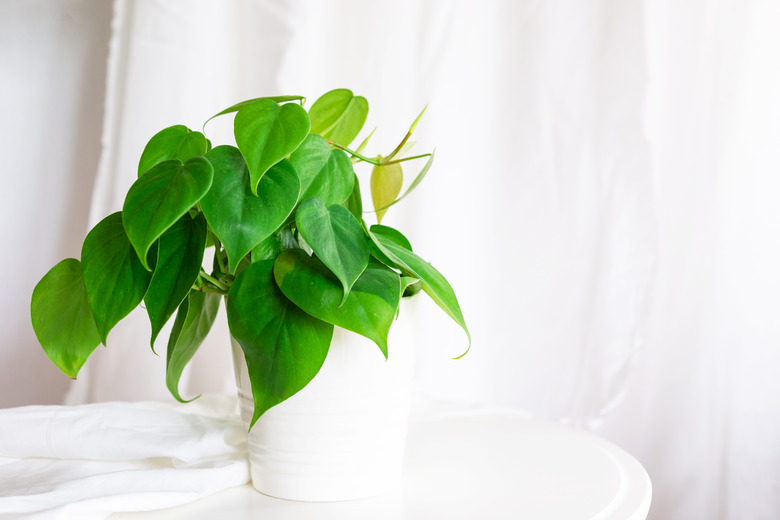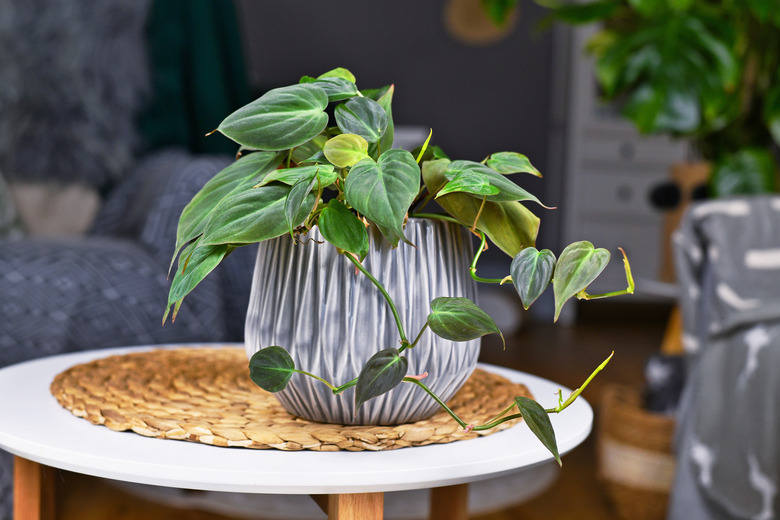How To Propagate Philodendron
Philodendrons (Philodendron spp.) includes more than 200 species of tropical plants. These include the fiddle leaf philodendrons (Philodendron bipennifolium, USDA zones 10b-11), heartleaf philodendron (Philodendron hederaceum, zones 11-12) and tree philodendron (Philodendron bipinnatifidum, zones 8b-11) commonly grown as houseplants. These plants are sensitive to cold temperatures, but they can be grown as perennials in U.S. Department of Agriculture plant hardiness zones 9 through 12, depending on species. Propagating them is relatively easy.
Tip & Stem Cuttings
Tip & Stem Cuttings
Philodendrons root easily from stem cuttings. Many can be rooted in a glass jar or vase of water, but cuttings develop a stronger root system if you root them in moist perlite or peat moss. Because philodendrons can be propagated by either tip or stem cuttings, you can root several plants from one vine.
For tip cuttings, cut off the tip of the vine's stem so that it contains the new leaves at the tip and at least one node on the stem. For stem cuttings, remove a stem and cut it into several 2 to 3 inch sections, with each section containing at least two nodes.
For rooting in water, place the cuttings in a vase of water with at least one node under the water's surface and set them in a warm area to root. Otherwise, dip the basal end (the end that faces the main plant) of the cutting in rooting hormone and insert it into moist potting medium with at least one node under the surface of the medium. Cover the pots with plastic and place them in an area that receives bright, indirect light. Maintain a soil temperature of 70 to 75 degrees Fahrenheit for optimal root formation.
Keep the soil moist, but not soggy until the roots are formed. To test root formation, gently tug on the cutting. If it resists your efforts, the roots are adequately formed. Transplant the new plants to individual pots.
Dividing Philodendrons
Dividing Philodendrons
Dividing an overgrown or mature philodendron is a quick way to gain new plants. Because each section already has an established root system, new growth appears quickly and the new plant typically thrives with minimal to no effects of transplant shock.
To divide, water the plant well to moisten and loosen the soil the morning before dividing the roots. This makes division easier and provides your philodendron with the moisture it needs to combat the stress of transplanting. Remove the plant from the container and gently pull the roots into two or more sections, making sure each section has at least one shoot. Repot the main plant in the original container and set the divisions aside for potting in fresh soil.
Air Layering
Air Layering
Overgrown philodendrons that begin to droop are good candidates for air layering. Select a section of the stem and remove the leaves 3 to 4 inches above and below a leaf node. Use a sharp sterilized knife to cut a 1/2-inch slit in the stem of the plant. Angle the cut upward so that it reaches to the center of the stem, but do not sever the stem.
Place a toothpick into the slit so that the width of the toothpick holds the slit open and the ends stick out on either side of the stem. This prevents the wound from healing. Dust the cut with rooting hormone to encourage good root formation.
Wrap a large handful of long-grain sphagnum peat moss around the cut and cover it with plastic wrap, using care to seal the edges to prevent moisture loss. Secure the plastic and peat moss in place with tape, string, or foil. Watch for new roots to form inside the plastic. Cut the new plant free of the main stem when the bag is filled with new roots and plant the new plant in soil.
Potting Media for Transplanting
Potting Media for Transplanting
Philodendrons prefer loose, well-drained soil high in organic matter. They can be planted on peat moss, a combination of peat moss and perlite or you can make your own potting medium with equal parts perlite, peat moss and either all-purpose potting soil or compost. Garden soil is not recommended for plants in containers because it is too heavy, compacting easily with repeated watering, and tends to drain slowly.
Transplanting Cuttings or Divisions
Transplanting Cuttings or Divisions
Fill your plant pot or container about three-fourths full with fresh potting medium. Position the rooted cutting or division into the plant pot and spread the roots out over the soil. Gently fill in around the roots with soil.
Adjust the cutting or division so that the crown, the area where the roots meet the stem, rests at the soil line. Firm the soil down with your hands to secure the plant. Place the new plants in an area that receives bright, indirect light, but avoid direct sunlight.

